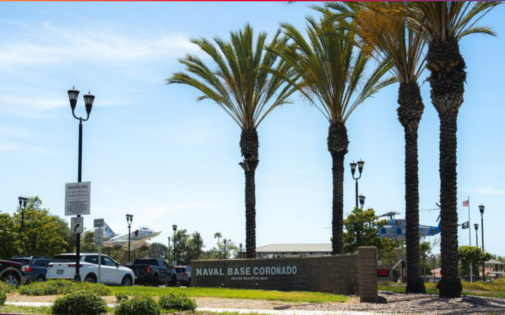The San Diego street race is the new buzzword in NASCAR. It will be an extraordinary Father’s Day weekend event filling fans and Southern California locals alike with excitement next year around June. It also marks NASCAR‘s first time racing on an active military base, promising unforgettable visuals and a salute to Navy Heritage. Yet, amid the hype, a financial wrinkle looms large.
One NASCAR insider warns that while the fanfare grows, costs for some teams, especially those hauling big rigs, could spiral, potentially undermining the very success NASCAR hopes to build in Southern California.
Does the Truck Series need San Diego, too?
The San Diego Street race is much more than a novelty; it is a strategic attempt to revive NASCAR’s presence in Southern California. Following races in Fontana from 1997 until 2023 and the LA Coliseum Clash from 2022 to 2024. It blends legacy with innovation, offering Cup, Xfinity and Truck Series competition on base grounds next year. However, one NASCAR insider is doubtful about the Truck Series traveling to San Diego.
The Truck Series is undoubtedly the most unique tier in NASCAR’s national series. Instead of racing stock cars, stock trucks are modified and race across most of the tracks where Cup and Xfinity races take place, with significantly fewer laps and more sensitive bodies. This makes road course racing quite a drag in the Truck Series, and besides that, the cost of making it to San Diego remains the primary issue.
In a YouTube video, insider Eric Estepp sounded the alarm. He went on to say, “My only other nitpick is that I’m not sure the Truck Series needs to be there. I say that having not yet spoken to any Truck Series owners or personnel or drivers or anything like that, but just a few weeks ago, there were reports that some Truck Series owners felt traveling to Las Vegas was too expensive, not cost-effective enough.”
Travel costs, travel reimbursement, and puny purses stand in the way. While NASCAR Cup teams and sponsors might make the event grand, smaller teams may not recoup the costs of hauling gear from the Atlantic to the Pacific side. Truck Series team officials have also admitted: “This is a complete dumpster fire… I am not trying to be dramatic; I don’t know how this truck series is going to survive, other than it’s just a rich man’s playground.”
Many teams barely break even, making long-distance races more of a financial burden than an opportunity. And if you wreck your truck due to no error of your own, all the expense incurred over the weekend goes down the drain, as teams placing 25th or worse in the Truck Series get no financial bonuses. Meanwhile, the road course truck racing isn’t all that captivating either.
Corey Heims won dominantly the inaugural truck series race at Lime Rock Park in 2025, leading 99/100 laps. This was just another example of why NASCAR needs to find its groove in choosing racetracks that deliver competitive Truck Series action. Corey Heim dominating the whole race is incredibly impressive, but once you realize he was the only one even close to winning, it taints its image. Echoing this sentiment, Eric Estepp added, “The Truck Series, in my opinion, should focus more on short tracks.”
However, Estepp leaves us all with something to think about. Without any confirmation from any NASCAR Truck teams, Eric said, “Do we need to see the Truck Series travel a million miles to run another road course? I’m not so sure. So, if I’m going to nitpick, and again, I haven’t talked to anyone, maybe truck teams are thrilled to be included. I could be way off base here. But based on recent reports, this seems like a very expensive undertaking for Truck Series teams that are currently looking to cut costs in many respects.”
Estepp is riding with the hope that a market like Southern California can make it profitable for these Truck Series teams to make the trip to the West Coast. However, the financial situation continues to grow dire, as recent rumors suggest that Spire Motorsports is potentially pulling out of the Truck series!
What’s next for Spire Motorsports?
The most prominent theory as of now? A full-time leap into the Xfinity Series starting in 2026. While Spire has doubled in the series before, making just four stars in 2023 with Carson Hocevar, selling off Truck Series assets could give the team the financial flexibility to secure a full-season Xfinity program, possibly even acquiring the remnant of the now-defunct Our Motorsports.
What is puzzling fans and insiders alike is the suggestion that Spire may shut down the No. 77 truck driven by reigning ARCA champion Andres Perez instead of one of their part-time entries like the No. 7. Perez, who has struggled to secure full-time sponsorship, would take a major hit if Spire Motorsports pulled his seat, especially considering the team as access to backers like Gainbridge and Group 1001. With Spire expanding into ARCA on the CARS Tour, the team appears to be reshaping against the development pipeline rather than abandoning it.
Adding fuel to the speculation is a wildcard. Spire could be preparing for a manufacturer. With Ram planning a return to trucks and no team officially tied to them yet, some believe Spire’s sale of assets could be part of a long-term plan, especially with whispers of Ram entering Cup by 2027. Whether it’s a move to Xfinity, restructuring of his lineup, or something even bigger, Spire’s next steps could shape multiple levels of NASCAR competition, and paint a vivid picture of how tough it is to sustain a Truck Series operation.
The post Insider Exposes Hidden Cost Trap Lurking Beneath NASCAR’s 2026 San Diego Debut Plans appeared first on EssentiallySports.
